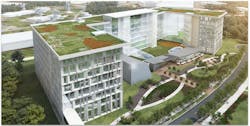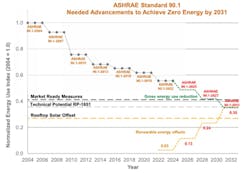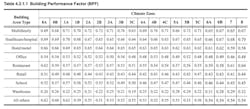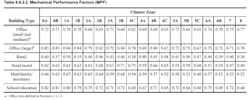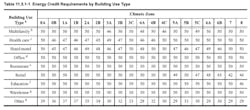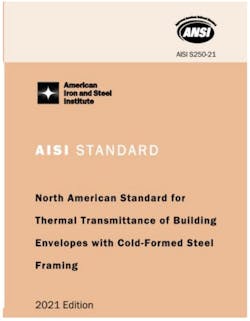The path to Net Zero Buildings has a long history with ASHRAE 90.1, beginning in 1975 with Title III of the Energy Conservation and Production Act (ECPA).
Of course, ECPA was published in response to the 1973 oil embargo, which had changed the way Americans thought about energy. When the cost of energy had soared, gasoline was rationed nationwide.
After several updates to the standard in 1995, Congress adopted 90.1 as the energy code for Federal Buildings and required states to adopt 90.1, or a code as restrictive, for commercial buildings and residential buildings taller than three stories.
Today, the purpose of ASHRAE 90.1 (2022) is to establish the minimum energy efficiency requirements of buildings other than low-rise residential buildings, for design, construction, and for development of a plan for operation and maintenance. Additionally, the purpose includes planning for utilization of on-site renewable energy resources.
Recently, ASHRAE set a goal for 90.1 to be a Net Zero Carbon Code by 2031. This means that even the worst building built in compliance with the 2031 code will be carbon neutral.
The 2022 code is the first step on the Path to Net Zero. The 90.1 committee will take three more steps to reach that goal in 2025, 2028, and 2031. In 2031, the standard will require a building to reach the technical minimum energy use as calculated by RP-1631.
RP-1631 is an ASHRAE Research Paper written in 2016 by Jason Glazer, the head of the 90.1 Energy Cost Budget Committee. Glazer’s study determined the least amount of energy that could be used in buildings in 2030 by employing commercially available methods without considering cost. The building would then need to have on-site renewables available to reach net zero. So, significantly, the 2022 standard is the first time on-site renewables have been required.
Personally, I have been a voting member on the 90.1 committee since the 1990’s and rejoiced with the committee when we issued the first ASHRAE Standard written in code-enforceable language in 1999. That was accomplished under the leadership of Ron Jarnagin, who later served as ASHRAE President (2011-12). I was also there when we ate cake and celebrated the 2010 edition, upon meeting the mandate set forth by the DoD and ASHRAE leadership, requiring the 2010 edition to be 30% more efficient than the 2004 baseline edition.
We accomplished that when Mick Schwedler rejoined the committee as chair to help us meet this ambitious goal. Mick, himself, later became ASHRAE President (2021-22), as well. Of course, I hope to be there in 2031 when we publish a Net Zero energy code.
ASHRAE 90.1 proposes to have a prescriptive path to Net Zero that will not require energy modeling. However, the 2022 edition introduces two new sections that do depend on energy models. They both use a form of the Building Performance Factor introduced for Appendix G in 2016.
Appendix G uses an independent baseline, drawn from standard practice; not completely based on the proposed building systems. It also employs a stable baseline approach using a building that meets the 2004 code requirements. Using that baseline, energy performance of the proposed building must exceed savings in an amount commensurate with the code year being evaluated, as determined by the Building Performance Factor.
The approach of using a target model and a factor developed by DOE's Pacific Northwest National Laboratory (PNNL) to compare to the proposed building modeled performance in Appendix G is now also used in the new Total System Performance Ratio (TSPR), and the new section 11, Additional Efficiency requirements. This is a clear indicator of what we will see in the future of 90.1.
TSPR - Alternate path for compliance
Users have long been requesting a per square foot energy use goal, and TSRP is a major step in that direction. TSPR is defined as the ratio of the sum of a building’s annual heating and cooling load in kBtu to the sum of annual energy input of the building mechanical systems, where the input units are in accordance with Section L5. (L is a new Appendix that is used with TSPR.)
As the developers of TSPR have explained to the committee, a larger TSPR indicates a lower heating and cooling energy cost to meet the loads, and therefore can be considered a more efficient HVAC system. The annual heating and cooling loads include envelope loads, internal loads due to lights, equipment, and occupants, as well as ventilation and infiltration loads.
This metric provides a single evaluation criterion which addresses all components of the HVAC systems used to move heat and air into, out of, and within a building. It includes distribution system effectiveness, considers both full and part load performances and accounts for system controls. That differs from standard system efficiency ratings (such as seasonal energy efficiency ratio, coefficient of performance, or kilowatt hours per ton) that usually address part of a system and fail to account for all the system inefficiencies that may be present within a building, as well as their interaction with building loads and ventilation requirements.
In addition, such component efficiency ratings are based on standard rating conditions that may not reflect actual building conditions and the climate of the building site. The HVAC System Performance approach accounts for all of these parameters to provide a comprehensive evaluation of a building’s HVAC system.
Significantly, the application of TSPR moves 90.1 toward using a system efficiency approach to code compliance and away from making minor prescriptive improvements in system components or controls. The TSPR is the ratio of heating and cooling delivered to cost (or other metric, maybe carbon) input. Since a larger proposed TSRP is required for compliance, the target is divided by a factor MPF.
TSPRp > TSPRr/MPF
There are 12 HVAC Systems currently included in TSRP and eight building types. Others will be added. To show compliance, use online free software from PNNL; the same providers of ComCheck. This software promises to be much simpler than an Appendix G model. https://energycode.pnl.gov/staging/HVACSystemPerformance
New Sect. 11 for 2022 – Additional Efficiency Requirements
For several years, the International Energy Conservation Code (IECC) has been requiring some additional energy savings measures on top of those included in the code. Now, 90.1 will also require new measures with a somewhat different calculation method. By allowing the user to pick which added savings measures they will use, the methods do not have to reach the same high bar for inclusion as something that is a part of the standard everyone must comply with.
Even so, each project must achieve the total number of credits required in Table 11.5.1-1. Each point represents about 0.1% of annual total building energy cost. So, 50 points is about 5% of annual total building energy cost.
Possible energy credits are listed by Climate Zone: E is for Envelope; H is for HVAC; W is for service Water heating; P is for Power; L is for Lighting; Q is for equipment; G is for load management. Choose the ones that fit the project for a total of 50 points. Again, the points allowance for these measures are from models developed by PNNL.
New Appendices
Part load energy use curves have been developed for the newly added Normative Appendix J, to produce more accurate models when the actual chiller curves are not available. Also, a new Informative Appendix I has been added to provide the math, allowing the requirements to be converted from cost to carbon-based.
New Prescriptive Measures
This is the year of the bridge for the building envelope. A new American Iron and Steel Institute (AISI) Standard has been developed and, based on this document, eight new requirements for thermal bridging have been added to 90.1. The previously added requirements for air barrier made a major impact on buildings by reducing air leakage. So, expect the bridging changes to have a similar impact on heat loss through the envelope. The first requirements for wall reflectance were also added. These are only in Climate Zone 0, at least for now.
Section 9 – Lighting
Section 9 now also includes requirements for horticultural lighting based on photosynthetic photon efficacy (PPE). Lighting and Power has generally lowered the lighting power allowances. For instance, an office building that was allowed 1 watt/ft2 in 2004 is now allowed 0.62 watts/ft2.
Section 10 – Other Equipment
Section 10 can be used by any of the subcommittees and has included the list of systems that must be sub-metered. Of note, refrigeration has been added to the systems that must be sub-metered.
For the first time, requirements for elevator efficiency have also been added, based on the ISO efficiency classes. Elevators must be “E” or better per ISO 25745-2, so elevators are now regulated.
Also, compressed air became regulated in 2022. We do not regulate how it is used, but how it is produced, with requirements for controls, part load optimization for systems over 25 HP, leak testing, and pipe sizing, etc. Overall, the biggest changes in the code are the first requirements for on-site renewables.
For new construction or additions, the building site must have renewable equipment sized to generate 0.5 Wft2 or 1.7 Btu/ft2 times the gross conditioned floor area for all floors up to the three largest floors. Exceptions are made for buildings with new construction under 10,000 ft2, in locations with low solar gain; where the roof is full of other equipment; where the roof is shaded by objects that are not part of the building; or for other than new construction. This requirement will grow over the next three code cycles.
In sum, the 2022 edition is an important first step toward Net Zero in 2031. There are important changes to the code and some indications of the direction the committee will follow are given. Still, more changes are on the horizon, of course. Indeed, Net Zero offers a daunting challenge for the 90.1 Standard Project Committee, but we are up to the task.
All these years later, it has been a fascinating ride on the 90.1 Committee and I’ve been honored to play a small part in this journey.
Note: I am just one voting member of the committee and what I have presented here are my impressions, not that of ASHRAE or the 90.1 Standards Project Committee.
#####
Based in Midlothian TX, the author, McHenry "Mack" Wallace, is Federal Practice Director for Mechanical Engineering at Jacobs and Executive Vice President of WiseWatt, LLC. He has been a licensed professional engineer for 48 years, with practical experience in mechanical systems dating back to the 1970s. Email: [email protected].
About the Author
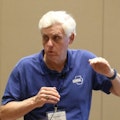
Mack Wallace
Based in Midlothian TX, the author, McHenry "Mack" Wallace, Jr., PE, LEED AP, is Federal Practice Director for Mechanical Engineering at Jacobs, and Executive Vice President of WiseWatt, LLC. He has been a licensed professional engineer since 1975, with practical experience in mechanical systems spanning five decades. For much of that time, Mack has been an active ASHRAE member and lecturer and even helped to create the first ASHRAE Standard written in Code language, 90.1-1999. Email: [email protected].
